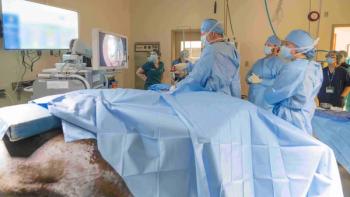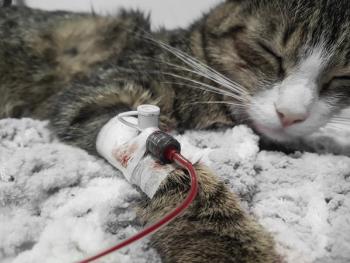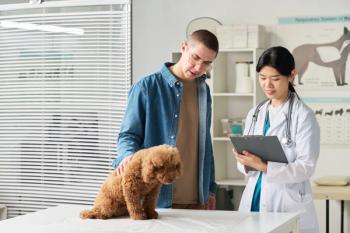
Idea Exchange: Perineal hernia repair: A new approach
This alternative method for repairing a common condition in male dogs offers advantages for both the patient and the surgeon.
Perineal hernia is a relatively common condition that occurs most commonly in middle-aged and older intact male dogs. For many years, the accepted technique for surgical repair has been to position the patient in ventral recumbency with the tail secured in hyperextension and the table tilted so that the patient’s head is down.
An alternative is to place the patient in dorsal recumbency with its rear legs hyperflexed at the hips to allow the perineum to be presented to the surgeon at a slightly less than vertical position. Advantages include:
• If the surgeon prefers to neuter from the standard position, there is minimal repositioning necessary between the neuter and hernia repair surgery.
• The respiratory system is less compromised since the table is not tilted with the animal's head down.
• The tail is not hyperextended so there is less stretching of the levator ani and no chance that the tail will become malpositioned during surgery.
• There is no pressure on the groin or front of the quadriceps muscles, which prevents sciatic nerve damage.
I perform the neuter before the hernia repair because I think there is less chance for fecal contamination when done in that order.
Click next to view a slideshow of how this procedure is performed.
Case report
Tank, a 7-year old intact male boxer, was first presented to our office with a one-month history of hematuria and a perineal hernia of unknown duration. A physical examination, laboratory evaluation, and imaging revealed an enlarged prostate gland in an otherwise healthy dog.
Tank was anesthetized and prepped for castration and perineal hernia repair. Gauze sponges impregnated with surgical lubricant were placed in the rectum, and a purse-string suture was applied. Tank was placed in standard position dorsal recumbency, and a routine orchiectomy was performed. The skin was closed with intradermal absorbable suture.
The drapes were removed, and Tank’s rear legs were hyperflexed at the hips and tied to the table so that his feet were next to his thorax. A thoracic positioner (v-tray) was used to stabilize the pelvis. The rear legs were brought cranially enough to have the perineum slightly tilted up toward the seated surgeon (Figure 1), and the site was once again prepped and draped.
Figure 1 (All photos courtesy of Dr. Lawrence Fox)
A curved incision was made over the perineal hernia bulge from a point roughly midway between the pubis and the ischial tuberosity to the tail base. The hernial sac (Figure 2) was incised, broken down, and reduced (Figure 3). Gauze sponges were placed in the incision to keep the hernia contents reduced while the next part of the surgery proceeded (Figure 4).
Figure 2
Figure 3
Figure 4
The following muscles were identified: the internal obturator, external anal sphincter, levator ani, and coccygeus (Figure 5).
The tendon of the internal obturator muscle was incised along the ischial tuberosity from lateral to medial, and the muscle and its tendon were elevated.
Figure 5
The gauze was removed and the hernia closed with size 0 polydioxanone suture in a simple interrupted pattern. The hernia was closed by suturing the levator ani and coccygeus muscles to the dorsolateral and lateral-most part of the external anal sphincter, and the elevated internal obturator was sutured starting with the most ventromedial part of the muscle and proceeding to the more lateral part of the muscle. It was sutured to the external anal sphincter and to the levator ani and coccygeus muscles to finish closing the hernia defect (Figure 6).
Figure 6
The subcutaneous tissue was closed with 3-0 poliglecaprone in a simple continuous pattern, and the skin was closed with 3-0 poliglecaprone in an intradermal pattern (Figure 7).
Figure 7
After surgery, the purse-string was removed, the gauze was removed from the rectum, and palpation was done to determine that no sutures perforated the rectal wall. Tank recovered from anesthesia and walked well on recovery. He was discharged that night, and the owner reported four incidents of apparent single fecal lump incontinence for the first few days but otherwise normal bowel movements, urination, defecation, and ambulation. Postoperative rechecks at nine and 15 days showed complete healing.
Thanks go to Drs. Howard Seim and Daniel Smeak who inspired this approach based on their lecture of dorsal positioning of cats for perineal urethrostomy during a soft tissue surgical meeting at the North American Veterinary Conference (NAVC) Institute.
Newsletter
From exam room tips to practice management insights, get trusted veterinary news delivered straight to your inbox—subscribe to dvm360.




